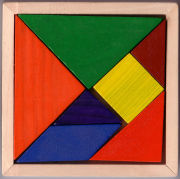
Tangram
Encyclopedia

Dissection puzzle
A dissection puzzle, also called a transformation puzzle or Richter Puzzle, is a tiling puzzle where a solver is given a set of pieces that can be assembled in different ways to produce two or more distinct geometric shapes. The creation of new dissection puzzles is also considered to be a type of...
consisting of seven flat shapes, called tans, which are put together to form shapes. The objective of the puzzle is to form a specific shape (given only an outline or silhouette) using all seven pieces, which may not overlap. It was originally invented in China
China
Chinese civilization may refer to:* China for more general discussion of the country.* Chinese culture* Greater China, the transnational community of ethnic Chinese.* History of China* Sinosphere, the area historically affected by Chinese culture...
at some unknown point in history, and then carried over to Europe
Europe
Europe is, by convention, one of the world's seven continents. Comprising the westernmost peninsula of Eurasia, Europe is generally 'divided' from Asia to its east by the watershed divides of the Ural and Caucasus Mountains, the Ural River, the Caspian and Black Seas, and the waterways connecting...
by trading ships in the early 19th century. It became very popular in Europe for a time then, and then again during World War I
World War I
World War I , which was predominantly called the World War or the Great War from its occurrence until 1939, and the First World War or World War I thereafter, was a major war centred in Europe that began on 28 July 1914 and lasted until 11 November 1918...
. It is one of the most popular dissection puzzle
Dissection puzzle
A dissection puzzle, also called a transformation puzzle or Richter Puzzle, is a tiling puzzle where a solver is given a set of pieces that can be assembled in different ways to produce two or more distinct geometric shapes. The creation of new dissection puzzles is also considered to be a type of...
s in the world.
Reaching the Western world (1815–1820s)
The tangram had already been around in China for a long time when it was first brought to America by Captain M. Donnaldson, on his ship, Trader, in 1815. When it docked in Canton, the captain was given a pair of Sang-hsia-k'o's Tangram books from 1815. They were then brought with the ship to Philadelphia, where it docked in February 1816. The first Tangram book to be published in America was based on the pair brought by Donnaldson.The puzzle was originally popularized by The Eighth Book Of Tan, a fictitious history of Tangram, which claimed that the game was invented 4,000 years prior by a god named Tan. The book included 700 shapes, some of which are impossible to solve.
The puzzle eventually reached England, where it became very fashionable indeed. The craze quickly spread to other European countries. This was mostly due to a pair of British Tangram books, The Fashionable Chinese Puzzle, and the accompanying solution book, Key. Soon, tangram sets were being exported in great number from China, made of various materials, from glass, to wood, to tortoise shell.
Many of these unusual and exquisite tangram sets made their way to Denmark
Denmark
Denmark is a Scandinavian country in Northern Europe. The countries of Denmark and Greenland, as well as the Faroe Islands, constitute the Kingdom of Denmark . It is the southernmost of the Nordic countries, southwest of Sweden and south of Norway, and bordered to the south by Germany. Denmark...
. Danish interest in tangrams skyrocketed around 1818, when two books on the puzzle were published, to much enthusiasm. The first of these was Mandarinen (About the Chinese Game). This was written by a student at Copenhagen University, which was a non-fictional work about the history and popularity of tangrams. The second, Der nye chinesisre Saadespil (The new Chinese Puzzle Game), consisted of 339 puzzles copied from The 8th Book of Tan, as well as one original.
One contributing factor in the popularity of the game in Europe was that although the Catholic Church forbade many forms of recreation on the sabbath, they made no objection to puzzle games such as the tangram.
The second craze in Germany and America (1891–1920s)
Tangrams were first introduced to the German public by industrialist Friedrich Adolf Richter around 1891. The sets were made out of stone or false earthenwareEarthenware
Earthenware is a common ceramic material, which is used extensively for pottery tableware and decorative objects.-Types of earthenware:Although body formulations vary between countries and even between individual makers, a generic composition is 25% ball clay, 28% kaolin, 32% quartz, and 15%...
, and marketed under the name "The Anchor Puzzle".
More internationally, the First World War saw a great resurgence of interest in Tangrams, on the homefront and trenches of both sides. During this time, it occasionally went under the name of "The Sphinx
Sphinx
A sphinx is a mythical creature with a lion's body and a human head or a cat head.The sphinx, in Greek tradition, has the haunches of a lion, the wings of a great bird, and the face of a woman. She is mythicised as treacherous and merciless...
", an alternate title for the "Anchor Puzzle" sets.
Paradoxes

Paradox
Similar to Circular reasoning, A paradox is a seemingly true statement or group of statements that lead to a contradiction or a situation which seems to defy logic or intuition...
is an apparent dissection fallacy: Two figures composed with the same set of pieces, one of which seems to be a proper subset of the other. One famous paradox is that of the two monk
Monk
A monk is a person who practices religious asceticism, living either alone or with any number of monks, while always maintaining some degree of physical separation from those not sharing the same purpose...
s, attributed to Dudeney, which consists of two similar shapes, one with and the other missing a foot.
Another is proposed by Sam Loyd
Sam Loyd
Samuel Loyd , born in Philadelphia and raised in New York, was an American chess player, chess composer, puzzle author, and recreational mathematician....
in The Eighth Book Of Tan:
Other similar, but possible, apparent paradoxes are in fact fallacious. For example, in the case of the two monks mentioned above, the foot is actually compensated for in the second figure by a subtly larger body.
Number of configurations
Over 6500 different tangram problems have been compiled from 19th century texts alone, and the current number is ever-growing. The number is finite, however. Fu Traing Wang and Chuan-Chin Hsiung proved in 1942 that there are only thirteen convexConvex polygon
In geometry, a polygon can be either convex or concave .- Convex polygons :A convex polygon is a simple polygon whose interior is a convex set...
tangram configurations (configurations such that a line segment drawn between any two points on the configuration's edge always pass through the configuration's interior, i.e., configurations with no recesses in the outline).
Pieces
Choosing a unit of measurement so that the seven pieces can be assembled to form a square of side one unit and having area one square unit, the seven pieces are:- 2 large right triangles (hypotenuse
 , sides
, sides  , area
, area  )
) - 1 medium right triangle (hypotenuse
 , sides
, sides  , area
, area  )
) - 2 small right triangle (hypotenuse
 , sides
, sides  , area
, area  )
) - 1 squareSquare (geometry)In geometry, a square is a regular quadrilateral. This means that it has four equal sides and four equal angles...
(sides , area
, area  )
) - 1 parallelogramParallelogramIn Euclidean geometry, a parallelogram is a convex quadrilateral with two pairs of parallel sides. The opposite or facing sides of a parallelogram are of equal length and the opposite angles of a parallelogram are of equal measure...
(sides of and
and  , area
, area  )
)
Of these seven pieces, the parallelogram is unique in that it has no reflection symmetry
Reflection symmetry
Reflection symmetry, reflectional symmetry, line symmetry, mirror symmetry, mirror-image symmetry, or bilateral symmetry is symmetry with respect to reflection. That is, a figure which does not change upon undergoing a reflection has reflectional symmetry.In 2D there is a line of symmetry, in 3D a...
but only rotational symmetry
Rotational symmetry
Generally speaking, an object with rotational symmetry is an object that looks the same after a certain amount of rotation. An object may have more than one rotational symmetry; for instance, if reflections or turning it over are not counted, the triskelion appearing on the Isle of Man's flag has...
, and so its mirror image
Mirror image
A mirror image is a reflected duplication of an object that appears identical but reversed. As an optical effect it results from reflection off of substances such as a mirror or water. It is also a concept in geometry and can be used as a conceptualization process for 3-D structures...
can only be obtained by flipping it over. Thus, it is the only piece that may need to be flipped when forming certain shapes.
Further reading
- Anno, Mitsumasa. Anno's Math Games (three volumes). New York: Philomel Books, 1987. ISBN 0399211519 (v. 1), ISBN 0698116720 (v. 2), ISBN 039922274X (v. 3).
- Botermans, Jack, et al. The World of Games: Their Origins and History, How to Play Them, and How to Make Them (translation of Wereld vol spelletjes). New York: Facts on File, 1989. ISBN 0816021848.
- Dudeney, H. E. Amusements in Mathematics. New York: Dover Publications, 1958.
- Gardner, MartinMartin GardnerMartin Gardner was an American mathematics and science writer specializing in recreational mathematics, but with interests encompassing micromagic, stage magic, literature , philosophy, scientific skepticism, and religion...
. "Mathematical Games—on the Fanciful History and the Creative Challenges of the Puzzle Game of Tangrams", Scientific American Aug. 1974, p. 98–103. - Gardner, Martin. "More on Tangrams", Scientific American Sep. 1974, p. 187–191.
- Gardner, Martin. The 2nd Scientific American Book of Mathematical Puzzles and Diversions. New York: Simon & Schuster, 1961. ISBN 0671245597.
- Loyd, Sam. Sam Loyd's Book of Tangram Puzzles (The 8th Book of Tan Part I). Mineola, New York: Dover Publications, 1968.
- Slocum, Jerry, et al. Puzzles of Old and New: How to Make and Solve Them. De Meern, Netherlands: Plenary Publications International (Europe); Amsterdam, Netherlands: ADM International; Seattle: Distributed by University of Washington Press, 1986. ISBN 0295963506.
- Slocum, Jerry, et al. The Tangram Book: The Story of the Chinese Puzzle with Over 2000 Puzzles to Solve. New York: Sterling Publishing Company, 2003. ISBN 1-4027-0413-5.
External links
- "Tangram" by Enrique Zeleny, Wolfram Demonstrations ProjectWolfram Demonstrations ProjectThe Wolfram Demonstrations Project is hosted by Wolfram Research, whose stated goal is to bring computational exploration to the widest possible audience. It consists of an organized, open-source collection of small interactive programs called Demonstrations, which are meant to visually and...
- "New Tangram paradoxes" by Gianni A. Sarcone, Archimedes Laboratory Project

